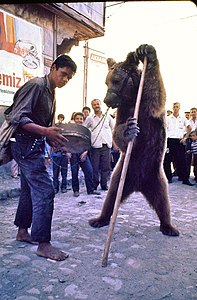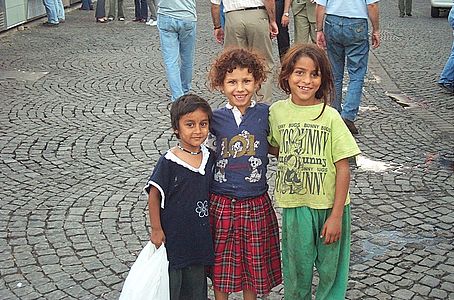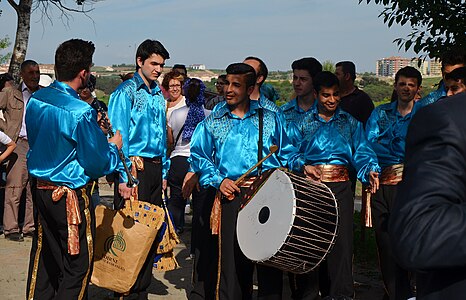Romani people in Turkey
This article uses bare URLs, which may be threatened by link rot. (January 2022) |
Romanlar | |
|---|---|
| Total population | |
| at least 500,000-5,000,000 | |
| Regions with significant populations | |
| Istanbul, East Thrace, Marmara Region, Aegean Region, İzmir Province | |
| Languages | |
| Balkan Romani, Turkish, Rumelian Turkish, Sepečides Romani, Rumelian Romani | |
| Religion | |
| Sunni Islam, Sufism, Bektashi Order | |
| Related ethnic groups | |
| Lom people, Dom people, Abdal of Turkey |
| Part of a series on |
| Romani people |
|---|
|
Romani people by sub-group
|
|
Romani diaspora by country
|
|
The Romani people in Turkey (Turkish: Türkiye'deki Romanlar) are Sunni muslims who speak Turkish as their first language, in their own accent, and take the Turkish culture. In Turkey, they identify themselves as Romanlar and not as Roma. They are also called Şopar (Gypsy kid) in Rumelian Romani dialect, and Çingene (Gypsy) in Turkish.[1] As Gastarbeiter some Men and Families came to Germany and Austria.[2]
East Thrace, where the majority of the Romanlar live in, is called Gypsy-County.[3]
There are officially about 500,000 Romani people in Turkey.[4][5][6][7]
History[]
There are records of the presence of Romani people from AD 800 in Thrace, known in Greek as Athinganoi and in Turkish as Çingene. Sulukule in Istanbul is the oldest Roma settlement in Europe, recorded in 1054.
The Ottoman Turkish Historian Evliya Çelebi explain in his Seyahatnâme, that Mehmed the Conqueror in 1453, take Muslim Roma Musicians from Balat, Didim and Roma from Gümülcine, and settled in Istanbul, but both Groups didn't get along well.[8] With the expansion of the Ottoman Empire, Muslim Roma settled in Rumelia (southeastern Europe) under Ottoman rule. Uniquely to Ottoman history, the Muslim Roma people were given their own sanjak, or province, the Sanjak of the Çingene at Rumelia and the City Kirklareli, by the order of Suleiman the Magnificent at 1530.[9]
According to their own oral tradition, (but it varies in some stories), their Ancestors the Chandala, once came from Hindustan, to Roman Egypt, and settled in the city of Qift. From Egypt, they went as sutlers trough Anatolia and settled in Thrace.
Origin[]
The Romani people in Turkey[10] originate from the Indian subcontinent,[11][12][13][14][15][16][15] The linguistic evidence has indisputably shown that the roots of the Romani language lie in Central India: The language has grammatical characteristics of Indian languages and shares with them a big part of the basic lexicon, for example, body parts or daily routines.[17] More precisely, Romani shares the basic lexicon with Sanskrit and Prakrit.[18] Genetic findings in 2012 suggest the Romani originated in India.[12][13][19] Genetic influence of the Ottoman Empire on the Balkan-Roma population.[20]
In February 2016, during the International Roma Conference, the Indian Minister of External Affairs stated that the people of the Roma community were "children of India". The conference ended with a recommendation to the Government of India to recognize the Roma community, spread across 30 countries, as a part of the Indian diaspora.[21]
Migration to Turkey[]
During the Population exchange between Greece and Turkey in 1923, different Muslim Roma groups from Greece, like the Tütünčides (Tobacco traders/workers)[22] or the Sepetčides (Basketmakers)[23] moved to Turkey, and called Mübadil Romanlar[24]
Turkish speaking Muslim Roma from Bulgaria went from 1878 - 1989 in weaves to Turkey together with Turks and Pomaks.[25]
In 1950-1951 Muslim Roma from Bulgaria came to Turkey and settled in Çanakkale and surroundings.[26]
Demographics[]
The majority of the Romani people in Turkey live in East Thrace, Marmara Region and Aegean Region. Cities with a high percentage of Romanlar are Edirne and Istanbul. Romani people in Turkey speak Turkish as their first language, and no longer use Rumelian Sedentary Romani,[27] many of them deny their Romani origins and describe themselves as Turks, or only as Muslim. They see themselves as Turks and have the same cultural similarities with Turks, no similarities with Christian Roma from Europe.[28]
Culture[]
The Turkish Romani are Cultural Muslims, based on Sunni Islam in the Hanafi school, and practise male khitan (circumcision), engagements and weddings on a grand scale. The Roma bands and their special music in 9/8 beat and songs are particularly well known in Turkey. Belly dance, performed by women and men. In Edirne, they hold the Kakava festival every year.[29]
Marriages are held early, Girls when 13-16 age, Boys when 15–19 years old, large families are normal. The extended family, the clan and the elder's are given great respect. Marriages outside with a Gadjo (non-Romani) are rare and generally forbidden in the Turkish Romani society, but sometimes Turkish Romani women marry Gadjo Men, but the offsprings of such a couple are not considered as Romani anymore, only the offspring from a Turkish Rom Man with a Gadjo woman, the offspring is accepted as Romani too. The father is the head of the Turkish Romani family, society is based on a Patriarchy. Turkish Romani Women and girls are subordinate to Men. Girl abduction is practiced when the parents, family or the elders do not consent to the marriage. Conservative romani groups are e.g. , the long-established Tekkekapılı, Kağıtçılar (Papermakers), the semi-nomadic Bandırmalı, (named after Bandırma, but their ancestors once came from Greece around 1923), who all live in Selamsız Romani-quarter in Üsküdar. The Kağıtçılar, in particular, have their own dialect that is not understood by other roma groups in their neighborhood.[30][31]
Legal status[]
In modern Turkey, Muslim Romani do not have the legal status of an ethnic minority because they are traditionally adherents of the Islamic faith, adherents of which, regardless of ethnicity or race, are considered part of the ethnic majority in Turkey. This goes as far back as the Treaty of Lausanne (1923), in which Section III "Protection of Minorities" puts an emphasis on non-Muslim minorities.[32]
In popular culture[]
A group of Turkish Romani appears in the 16th century Ottoman Constantinople of the video game Assassin's Creed: Revelations.
A Turkish TV series made between 2004 and 2007 called "Cennet Mahallesi" is based on Istanbulite Romans.
Groups of Turkish Romanlar[]
Yerli and Çerge generic term[]
The majority of the Romani people in Turkey live in Eastern Thrace, mostly in the Kırklareli Province, they are divided into two Main groups, the Sedentary Yerli and the Semi-Nomadic Çerge. There are several subgroups of both, named after their old professions which they once practiced or which they still do in part, as example: the Sepetçiler (Basketmaker's), Çiçekçi (Flower seller), Cambazı (Horse trader), Ayıcılar (Bear-leader's), Demirci (Blacksmith), Çiçekçi (Flower seller), Sünnetçi (Circumciser), Subaşı (Water carrier), Kuyumcu (Goldsmith), Kalaycı (Tinsmith), Şarkıcı (Singer), Müzisyen (Musician), Elekçiler (Sieve maker's), Bohçacı (Bundler), Arabacı (Coachman), Katırcıları (Muleteer's), etc. However, mostly all of the different Romani groups today are Working poor in a wide variety of jobs. The Yerli and the Çerge, live together in the Mahalla, but they don't like each other. The Yerli speak only Turkish as their mother tongue, while the Çerge speak Turkish and Rumelian Romani.[33] Although both groups are Muslims, the Yerli look down on the Çerge, and consider them savage, uncivilized and keep their distance from them. Interestingly, the Yerli call themselves Romanlar, while they call the Çerge Çingeneler. The Yerli consider the Çerge to have once come from the Balkans to Eastern Thrace.[34]
Sepetçi subgroup[]
Since Ottoman empire, the Muslim basket weavers Romanlar were very respected alongside Roma musicians. Because those Romani people, who became Muslims after the conquest of Istanbul at 1453, set up the mehter band of the Ottoman military band and the best and richest basket makers of Istanbul came from Sulukule. The Basketmakers' Kiosk was also built in their honor, where the basket makers guild was based.[35] In East Thrace, the european part of turkey, in the Kırklareli Province,they are the Sepetçi Romanlar (Basket-weaver Roma), who are still doing their old job today and The Sepetçi Association was established in the Vize district of Kırklareli.[36] Also in Gelibolu they are a Group of Sepetçi whose Ancestor's came from Greece, still weave Baskets.[37] Also in other parts in Turkey, live descendants of the Basketmaker Roma, who once came from Greece, some of them still speak Sepečides Romani.
Hintli[]
A special case are some families in Istanbul who call themselves Hintli (meaning in Turkish: Indian people), explain their brown skin color as follows: They are the descendants of Muslim Indian men of the medical team who once doctored Ottoman soldiers, who were wounded during the Balkan War of 1912–13.[38] After the Balkan war, some of this Indian Muslim Men married Turkish widows and stayed in Istanbul.[39] Their offspring married each other, which explains their appearance. They do not want to be called Romanlar, but their lifestyle and music do not distinguish them from the Romanlar in Istanbul.
Gallery[]

Postcard of a Muslim Romani Men with his 8 Wives and 10 Children, in front of their tent in Smyrne (today the city of Izmir) in 1903.

A dancing bear around 1970 in Samsun. His holder beats the frame drum Def.
Romani in Istanbul in 2008.
Romani men of Turkey.

Children in Ortaköy in Istanbul, 2000.
Notable Turkish people of Romani heritage[]
- Sibel Can, folk pop and classical music singer
- Didem, belly dancer, model and singer
- Kibariye, Arabesque-pop singer
- Özcan Purçu, politician
- Hüsnü Şenlendirici, musician
- Selim Sesler, clarinet virtuoso
- Ankaralı Turgut, musician
- Rafet el Roman, Popstar
- , musician[40]
See also[]
- Minorities in Turkey
- Abdal of Turkey
- Muslim Roma
References[]
This article uses bare URLs, which may be threatened by link rot. (October 2021) |
- ^ "Mehr als nur Roman Havası - Roma in der Türkei". 8 April 2019.
- ^ https://www.coe.int/t/dg4/education/roma/Source/RomaniEurope_EN.pdf
- ^ http://www.errc.org/roma-rights-journal/the-perception-of-gypsies-in-turkish-society/
- ^ "UNHCR - Document Not Found". Archived from the original on 2012-10-10. Retrieved 2014-06-17.
- ^ Schleifer, Yigal (21 July 2005). "Roma Rights Organizations Work to Ease Prejudice in Turkey". Eurasianet.org. Retrieved 15 December 2017.
- ^ "Archived copy". Archived from the original on 2009-07-29. Retrieved 2010-02-15.
{{cite web}}: CS1 maint: archived copy as title (link) - ^ "Archived copy". Archived from the original on 2012-10-20. Retrieved 2010-03-24.
{{cite web}}: CS1 maint: archived copy as title (link) - ^ "THE GYPSIES OF ISTANBUL | History of Istanbul".
- ^ https://rm.coe.int/ottoman-empire-factsheets-on-romani-history/16808b193d
- ^ "Roman Ruhu - Turkish Roma". YouTube.
- ^ Hancock, Ian F. (2005) [2002]. We are the Romani People. Univ of Hertfordshire Press. p. 70. ISBN 978-1-902806-19-8: ‘While a nine century removal from India has diluted Indian biological connection to the extent that for some Romani groups, it may be hardly representative today, Sarren (1976:72) concluded that we still remain together, genetically, Asian rather than European’
{{cite book}}: CS1 maint: postscript (link) - ^ a b Mendizabal, Isabel (6 December 2012). "Reconstructing the Population History of European Romani from Genome-wide Data". Current Biology. 22 (24): 2342–2349. doi:10.1016/j.cub.2012.10.039. PMID 23219723.
- ^ a b Sindya N. Bhanoo (11 December 2012). "Genomic Study Traces Roma to Northern India". The New York Times.
- ^ Current Biology.
- ^ a b K. Meira Goldberg; Ninotchka Devorah Bennahum; Michelle Heffner Hayes (2015-10-06). Flamenco on the Global Stage: Historical, Critical and Theoretical Perspectives. p. 50. ISBN 9780786494705. Retrieved 2016-05-21.
- ^ Simon Broughton; Mark Ellingham; Richard Trillo (1999). World Music: Africa, Europe and the Middle East. Rough Guides. p. 147. ISBN 9781858286358. Retrieved 2016-05-21.
Roma Rajastan Penjab.
- ^ Šebková, Hana; Žlnayová, Edita (1998), Nástin mluvnice slovenské romštiny (pro pedagogické účely) (PDF), Ústí nad Labem: Pedagogická fakulta Univerzity J. E. Purkyně v Ústí nad Labem, p. 4, ISBN 978-80-7044-205-0, archived from the original (PDF) on 2016-03-04
- ^ Hübschmannová, Milena (1995). "Romaňi čhib – romština: Několik základních informací o romském jazyku". Bulletin Muzea Romské Kultury. Brno (4/1995).
Zatímco romská lexika je bližší hindštině, marvárštině, pandžábštině atd., v gramatické sféře nacházíme mnoho shod s východoindickým jazykem, s bengálštinou.
- ^ "5 Intriguing Facts About the Roma". Live Science. 23 October 2013.
- ^ Bánfai, Zsolt; Melegh, Béla I.; Sümegi, Katalin; Hadzsiev, Kinga; Miseta, Attila; Kásler, Miklós; Melegh, Béla (13 June 2019). "Revealing the Genetic Impact of the Ottoman Occupation on Ethnic Groups of East-Central Europe and on the Roma Population of the Area". Frontiers in Genetics. 10: 558. doi:10.3389/fgene.2019.00558. PMC 6585392. PMID 31263480.
- ^ "Can Romas be part of Indian diaspora?". Khaleejtimes.com. 29 February 2016. Retrieved 4 March 2016.
- ^ https://www.researchgate.net/figure/The-Roma-tobacco-workers-who-live-in-Ortakoey-Besiktas-with-leftist-intellectuals-of-1960s_fig2_286766087
- ^ "Sepečides / Sevlengere Roma".
- ^ "Unutulan Mübadil Romanlar: 'Toprağın kovduğu insanlar'". 7 February 2021.
- ^ Maeva, Mila. "(PDF) Маева, М. Българските турци-преселници в Р Турция (култура и идентичност). 2005. Bulgarian Turks - Emigrants in Turkey (Culture and Identity). София: IMIR. | Mila Maeva - Academia.edu".
{{cite journal}}: Cite journal requires|journal=(help) - ^ https://www.acarindex.com/pdfler/acarindex-4982-5629.pdf
- ^ "Rumelian Sedentary: Dialect Sampler, Romani Dialects Interactive - ROMANI Project Manchester".
- ^ http://www.errc.org/uploads/upload_en/file/03/37/m00000337.pdf
- ^ Elena Marushiakova, Veselin Popov (2001) "Gypsies in the Ottoman Empire", ISBN 1902806026University of Hertfordshire Press
- Original: Елена Марушиакова, Веселин Попов (2000) "Циганите в Османската империя". Литавра, София (Litavra Publishers, Sofia).(in Bulgarian)
- ^ "Home".
- ^ "Home".
- ^ "Treaty of Lausanne - World War I Document Archive". Lib.byu.edu. Retrieved 15 December 2017.
- ^ https://humstatic.uchicago.edu/slavic/archived/papers/Friedman-OldestBalkRmiw-BDankoff.pdf
- ^ https://dergipark.org.tr/tr/download/article-file/751137
- ^ "SEPETÇILIK - Definition und Synonyme von sepetçilik im Wörterbuch Türkisch".
- ^ "Vize'de Sepetçi Romanları Derneği açılışına ilgi".
- ^ "Sepetçiler ata mesleğini devam ettirme çabasında".
- ^ "Heritage Times - the Indian Subcontinent Red Crescent Society's Aid to the Ottoman State during the Balkan war in 1912". 30 April 2020.
- ^ "The Indian Muslims who Helped the Ottomans During the Balkan Wars". 6 March 2019.
- ^ "Clarinet Genius Cüneyt Sepetçi: From Weddings to World Music". 23 October 2019.
External links[]
![]() Media related to Romani people in Turkey at Wikimedia Commons
Media related to Romani people in Turkey at Wikimedia Commons
- Romani in Turkey





